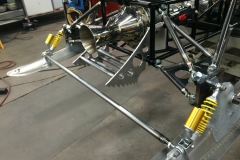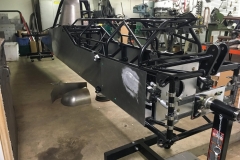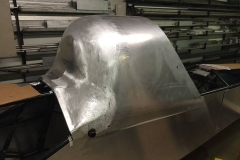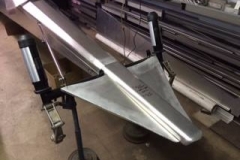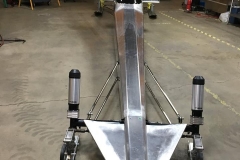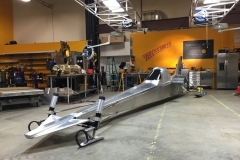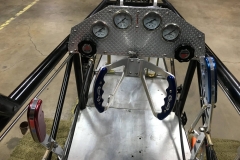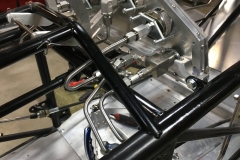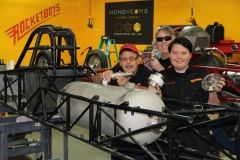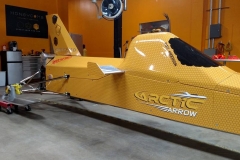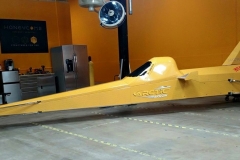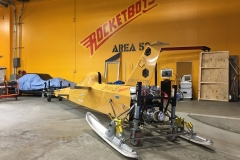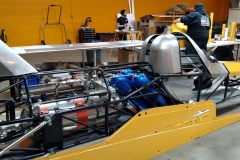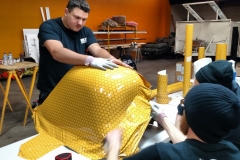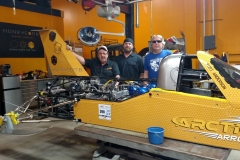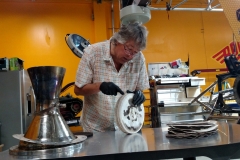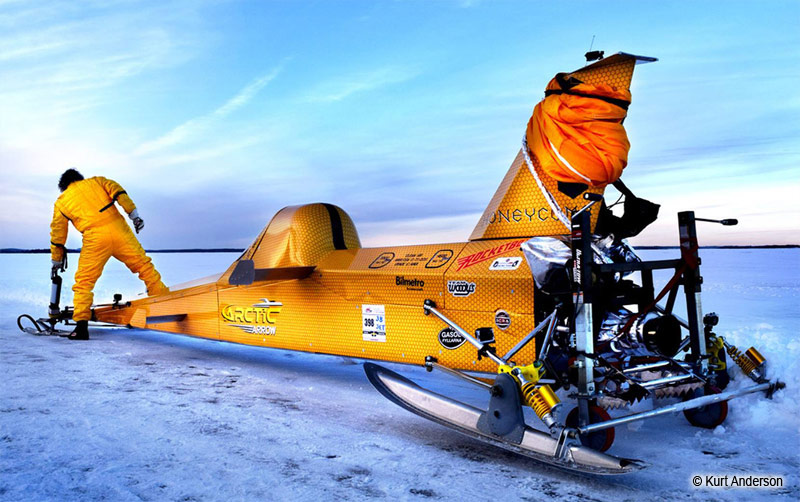
Rocketboys record attempt in Sweden
Kurt Anderson and his Arctic Arrow – rocket powered ice machine will be attempting to break the world record of 247.93 MPH on ice which has been uncontested for 34 years. The current record was set 2/15/1981 by the late great Slam’n Sammy Miller on Lake George in New York.
The Arctic Arrow is a purpose build vehicle designed by Kurt to run on ice at over 300 MPH. The propulsion system was originally built by legionary rocket builder Ky Michaelson. Kurt Anderson has done several modifications on the system to improve performance in sub-zero temperatures.
After over two years of hard work, Kurt feels confident all the systems for speed and safety will perform and allow him to achieve his goal.
“There is nothing safe about going over 300 Mph on ice, but the Arctic Arrow has been built to do the job and keep me safe if something does go wrong on a run. We are excited to participate in Speed Weekend and work with the team at Landracing.se to set a new World Record on ice, and enjoy the hospitality at Årsunda Strandbaden!”
2017 Arctic Arrow Fuel and Motor Heating
Fuel
- 55 gallon drums have electric heating blankets internally set to 100 F. These blankets get placed between the drums and their over-packs. Insulate over-packs as much as possible for energy efficiency. The drums must stay vented, the drums and over-packs should be checked at least every 8 hours for signs of leaking and to record drum temperature. After 24 hour of monitoring of stabilized activity, checks can be scheduled every 12 hours until race days.
- Vehicle Tank heating: The Arctic Arrow has 3 electric tank heaters and two digital temperature probes. After fuel has been loaded into the tank the digital thermometer should be attached and turned on. The starting temps should be recorded then check that the fill cap is off and tank vent is open. After that power on the heaters and set level knobs to 3. Check temp via digital thermometer and IR temp gun every 15 minutes and record results. The max high temperature for the fuel tank is 125 F.
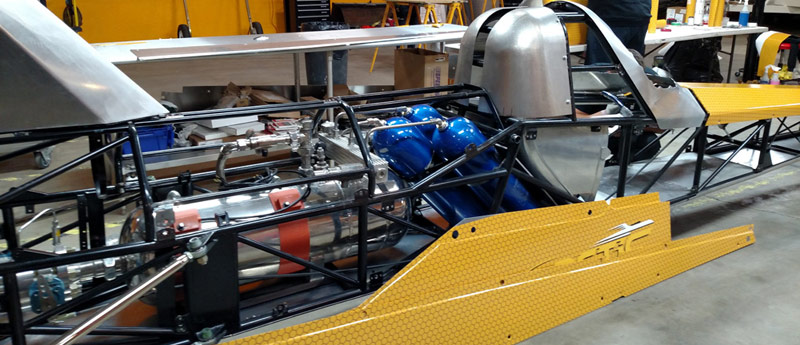
Rocket Motor
When heating the rocket motor make sure there is plenty of ventilation and nothing combustible in the area. This duty requires 100% of your attention. Once the heater is lit it must be supervised.
First the Rocket Motor Heater needs to be connected to LPG fuel and electrical power. When it is located behind the Rocket Motor connect the high temperature cutoff, and connect the Rocket Motor digital thermometer and power on. Have the IR handheld thermometer available as well.
Place the nozzle of the Rocket Motor Heater about 6’ away from the Rocket Motor Nozzle and turn on the LPG valve and heater switch. It will light in a matter of seconds, adjust spacing as needed.
The motor will heat fairly fast and require heating cycles to allow the hot areas to transfer heat deep into the motor.
The nozzle temp should not exceed 700 F when it gets close to that power off the heater and monitor digital thermometer temps until they equalize. Start heater as needed and record temp and times including outdoor temp. Max motor internal temp is 800 F.
Once temp is reached notify Crew Chief, close LPG valve, cut power, and move heater off runway to a safe area.
Remove Rocket Motor digital thermometer and let Crew Chief know motor heating is complete.
2017 Arctic Arrow Launch Checklist
Prepare Arctic Arrow
- Close dome supply valve
- Open tank vent valve
- Pressurize fuel pressure tanks to 2500 PSI adjust as required to a max of 3300 PSI
- Pressurize brake supply tank to a max of 3500 PSI
- Ensure primary throttle valve is closed
- Ensure secondary throttle valve is open
- Ensure parachutes are packed properly
- Load fuel into fuel tank
- Start heating loaded fuel – inlet cap open
- Monitor tank temperature
- When tank temp reaches 100 F Motor pre-heating can start
- Seal inlet cap and make sure tank overflow valve is closed
- Full crew radio check
Pre-launch
- All fuel secure
- Team tent secure or supervised
- All team members accounted for and launch plan understood by everyone
- Event organizers have approved launch
- 3rd party public safety aware and in place
Launch Procedures
Driver – Full safety gear on. Suit, boots, gloves, next restraint, helmet, earpiece and mic
- Driver – Full safety gear on. Suit, boots, gloves, next restraint, helmet, earpiece and mic.
- External motor heating continues or starts.
- Track is clear and safety personal in place with needed equipment.
Everyone close by should have safety glasses and vapor mask in hand. NO ONE BEHIND ROCKET Accept motor heater personal – At this point only Team members are close to vehicle. - Second radio test.
- Rocket motor heated launch temp and heater removed from runway.
Ready to run
- Confirm vehicle is properly lined up
- Track all clear
- Close tank vent
- Arm vehicle and set primary pressure
- Perk motor
- Set run pressure
- All clear from all departments
- Make run
- Vent fuel tank – Give all clear for pickup.
NO ONE SHOULD EVER GET BEHIND ROCKET WITHOUT ALL CLEAR NOTICE!
Copyright © 2019 All Rights Reserved by Kurt Anderson
2017 Arsunda Sweden Arctic Arrow Team Bios
Ky Michaelson – Crew Chief
Ky Michaelson has been involved in rocket car propulsion dating back to 1969 when he started to get involved with the very first Rocket Car the X-1. Since then he has created over 36 rocket powered vehicles and consulted on the building of dozens more. In 1970 Ky held the Guinness World Speed Record driving a rocket powered snowmobile (Sonic Challenger) at 114.5 Mph set on 2-15-1970. Ky holds over 72 speed records with rocket powered vehicles. He has direct involvement of over 300 rocket car runs. There is no other man on this planet that know more about rocket car propulsion. He was also the first amateur to launch a rocket into space. His accreditations could go on forever.
Kevin O’Kelly – Chassis
Kevin O’Kelley is a master welder and fabricator. He is Kurt Anderson’s Crew Chief on his Top Fuel and Alcohol Dragsters. Kevin has been a racing team member since 2007 and has his own experience drag racing since the 1980s. His attention to details and high safety standards ensure the vehicle is ready before it gets to the track.
Buddy Michaelson – Crew Assistant and Fuel Transfer Coordinator
Buddy Michaelson is Ky’s son and has been involved in rockets from an early age. He has crewed on Kurt Anderson’s Sonic Stinger Rocket car runs and worked with his father on many rocket projects including the 2004 and 2014 CSXT rocket launches to space.
Captain Jack McClure – Commander and Chief/Safety Supervisor
Capt. Jack started using rockets on go-karts in 1963 his is truly a rocket using legend of our time. He has safely maintained and driven his rocket powered go-kart over 200 times. He is now 91 and still drive his rocket kart. http://www.captjackmcclure.com/
Dan Swanson – Fuel and Motor Heating Engineer
Dan is commercial plumber by trade, experienced in high pressure plumbing and heating systems. His duties include monitoring the fuel and rocket motor heating processes.
Steve Wagner – Team Chef, Team Assistant, Track and Weather
Steve has been a longtime friend of Kurt Anderson. He is a finish carpenter by trade and a master chef. He also has a high attention to detail and is very safety minded. He brings a special skill set to the team and is well respected for his insights.
Click here to check out an article on the Arctic Arrow on Dragzine.com

